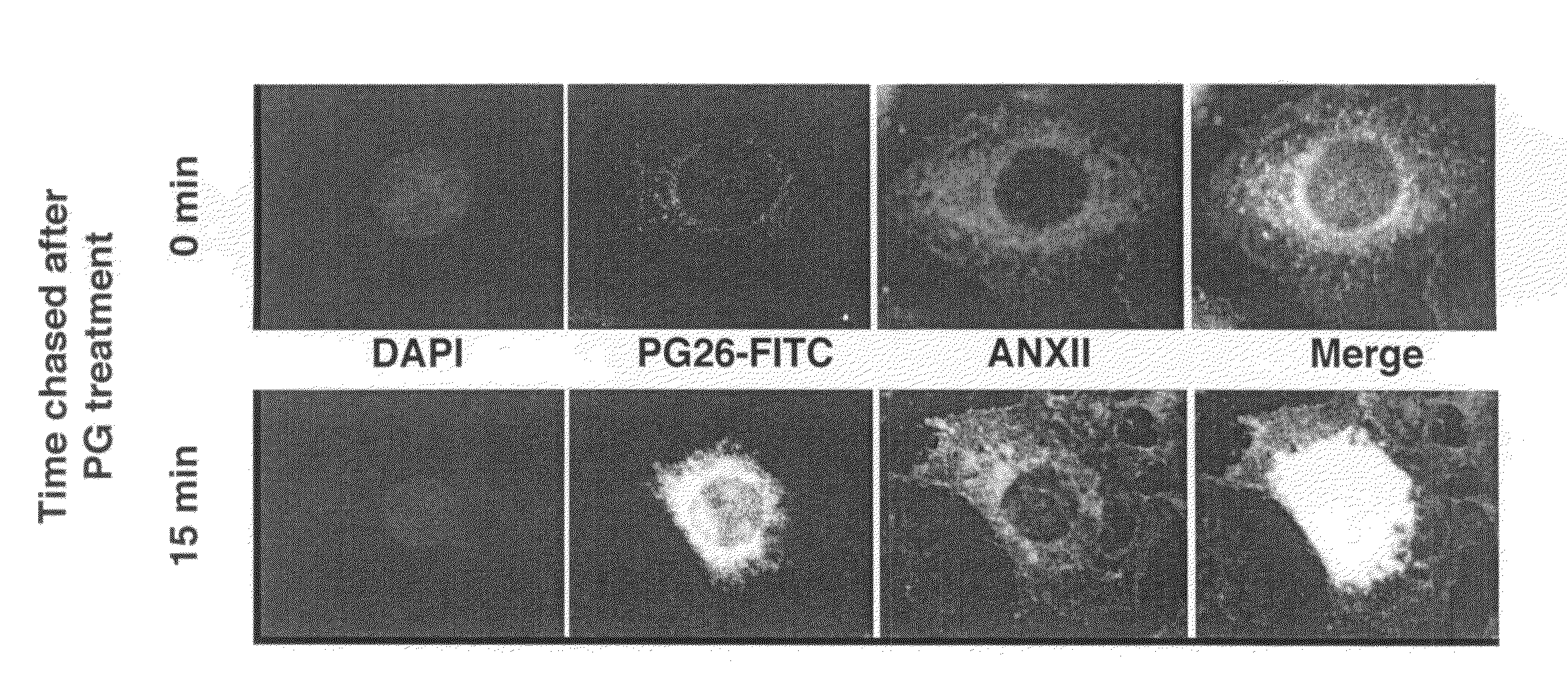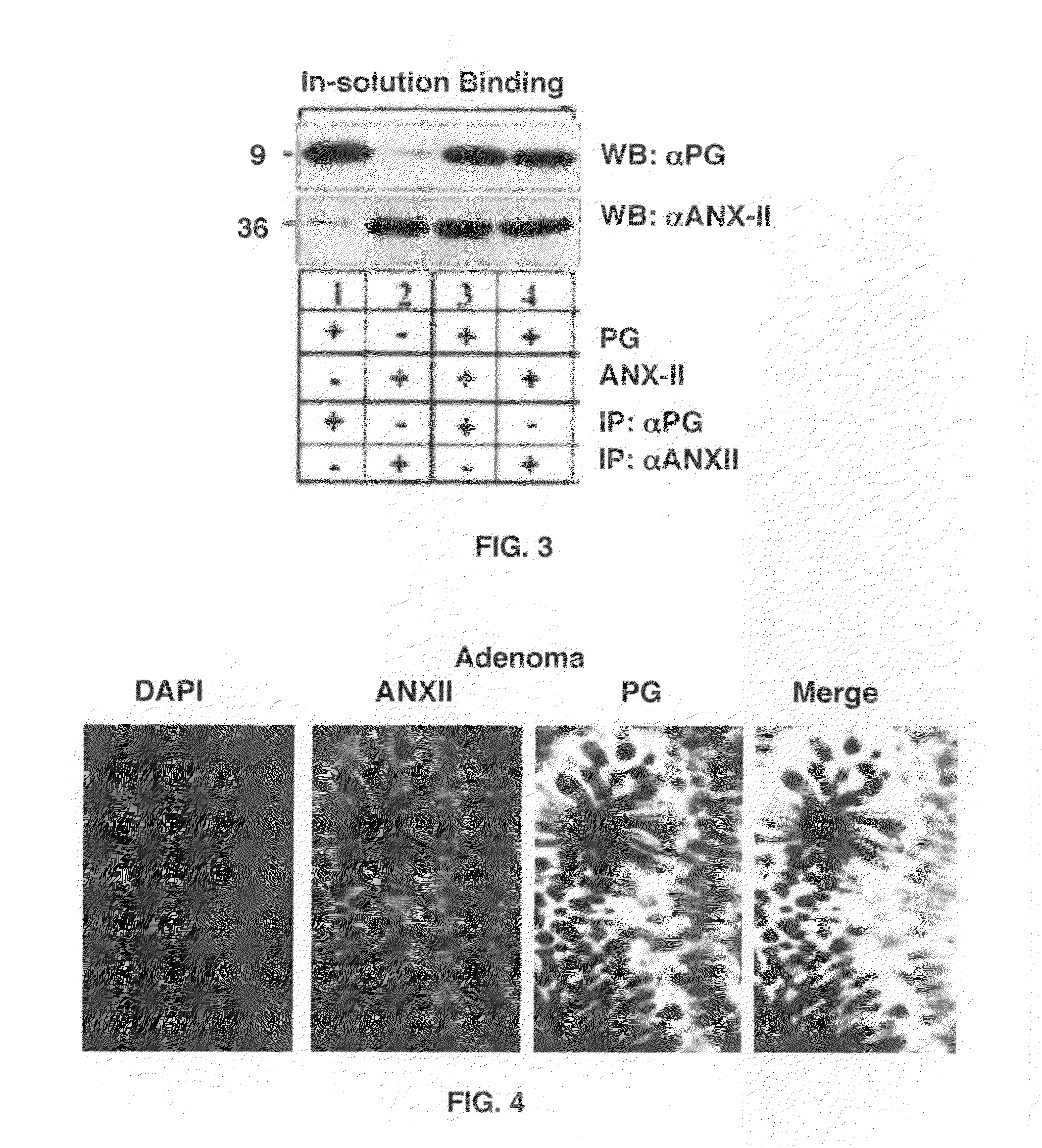Diagnosis and treatment of epithelial cancers using labeled/conjugated progastrin peptides
- Summary
- Abstract
- Description
- Claims
- Application Information
AI Technical Summary
Benefits of technology
Problems solved by technology
Method used
Image
Examples
example 1
Targeting Annexin A2
[0066]The Annexin (Anx) family of proteins is characterized by the presence of a conserved core domain and a variable amino terminal ‘tail’ domain responsible for specialized functions (24). Anx A2 is a multi-functional protein, and can bind p11 forming an (Anx2)2 / (p11)2 heterotetramer. Anx A2 binds several ligands with relatively high affinity including tPA on endothelial cells and progastrins on epithelial cells. Proteomic analysis of epithelial tumors reveals that Anx A2 is elevated many fold in human epithelial cancers (including renal, lung, pancreas, breast, colorectal cancers, etc) (24-27). Anx A2 is up-regulated in gastric epithelial cancers infected with H. pylori and may play a role in gastric carcinogenesis (27). Importantly Anx A2 is not detected on quiescent cells in the liver and elsewhere (24). Anx A2 is especially over-expressed at the leading edges of the tumor (27), suggesting the presence of this membrane receptor on rapidly proliferating tumor...
example 2
Progastrin Peptides for Targeting Anx A2
[0067]Relative binding affinity (RBA) of gastrins for the 36 kDa Anx A2 protein, prepared from cancer cells / tumor membranes was in the order of PG>G-Gly>G17, with no affinity for cholecystokinin CCK8 (28). While PG peptides demonstrated a high affinity for Anx A2, amidated gastrins (G17, G34) demonstrated a much higher affinity for CCK1R / CCK2R (FIG. 2). Direct binding of Anx A2 and rhPG was further established in an in vitro binding assay (FIG. 3). Functional significance of PG binding to Anx A2 was strongly suggested by the fact that rapidly dividing immortalized cells (IEC, HEK-293) and cancer cell lines (from ovaries / colons), responsive to the growth effects of PG peptides, demonstrated strong co-localization of PG with Anx A2. Adenoma and adenocarcinomas tissue sections (from ovarian and colorectal cancers of patients) were positive for Anx A2 expression, while normal tissues were negative (FIGS. 4, 5A-5B). Immortalized intestinal epitheli...
example 3
Affinity of Labeled Progastrin (PG) Peptides for Tumors Overexpressing Anx A2
[0069]It was critical to demonstrate that labeled PG peptides can home to tumors, in situ, which are over-expressing Anx A2. For data presented in FIGS. 2-4, 5A-5B and 6A-6E, the full length 80 amino acid rhPG was used (SEQ ID NO: 2), which was visualized by staining with fluorescently labeled primary or secondary antibodies. However, in order to examine the feasibility of using PG peptides for diagnostic and treatment purposes, synthesized FITC labeled PG fragments (PG26, SEQ ID NO 1: QGPWLEEEEEAYGWMDFGRRSAEDEN) conjugated with either radio- or fluorescently labeled imaging reagents (for diagnostic purposes), or with cytotoxic payloads (for therapeutic purposes) was studied. PG26 was biologically active. Fluorescein isothiocyanate (FITC) labeled PG26 peptide demonstrated an equivalent binding affinity for Anx A2 as rhPG. Endocytotic internalization of FITC-PG26 in PG responsive immortalized kidney embryoni...
PUM
| Property | Measurement | Unit |
|---|---|---|
| Fraction | aaaaa | aaaaa |
| Fraction | aaaaa | aaaaa |
| Fraction | aaaaa | aaaaa |
Abstract
Description
Claims
Application Information
 Login to View More
Login to View More - R&D
- Intellectual Property
- Life Sciences
- Materials
- Tech Scout
- Unparalleled Data Quality
- Higher Quality Content
- 60% Fewer Hallucinations
Browse by: Latest US Patents, China's latest patents, Technical Efficacy Thesaurus, Application Domain, Technology Topic, Popular Technical Reports.
© 2025 PatSnap. All rights reserved.Legal|Privacy policy|Modern Slavery Act Transparency Statement|Sitemap|About US| Contact US: help@patsnap.com



